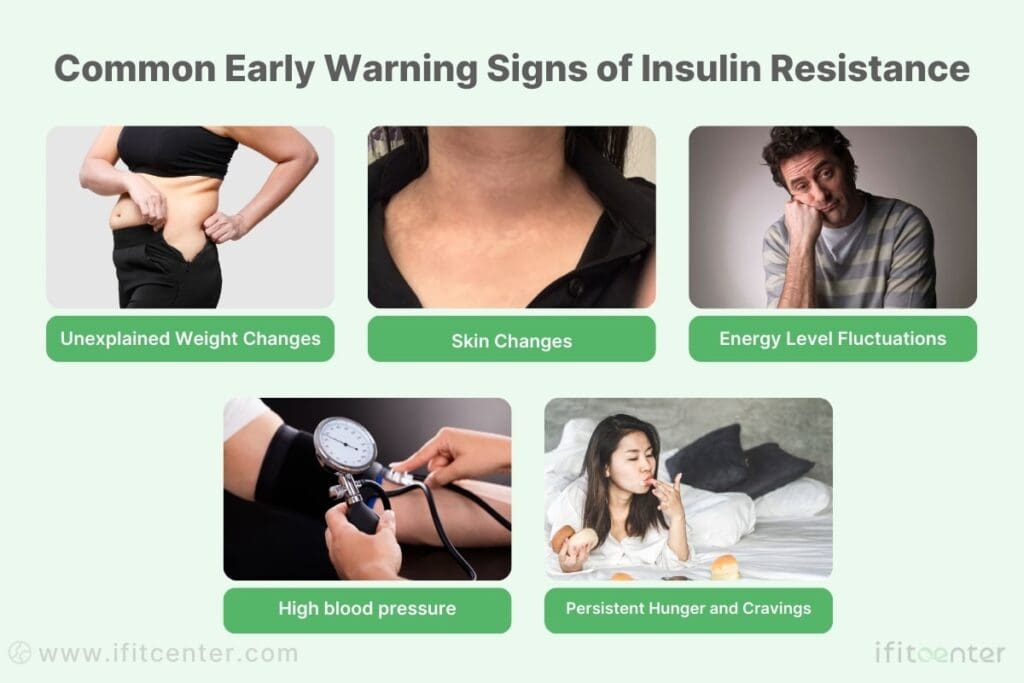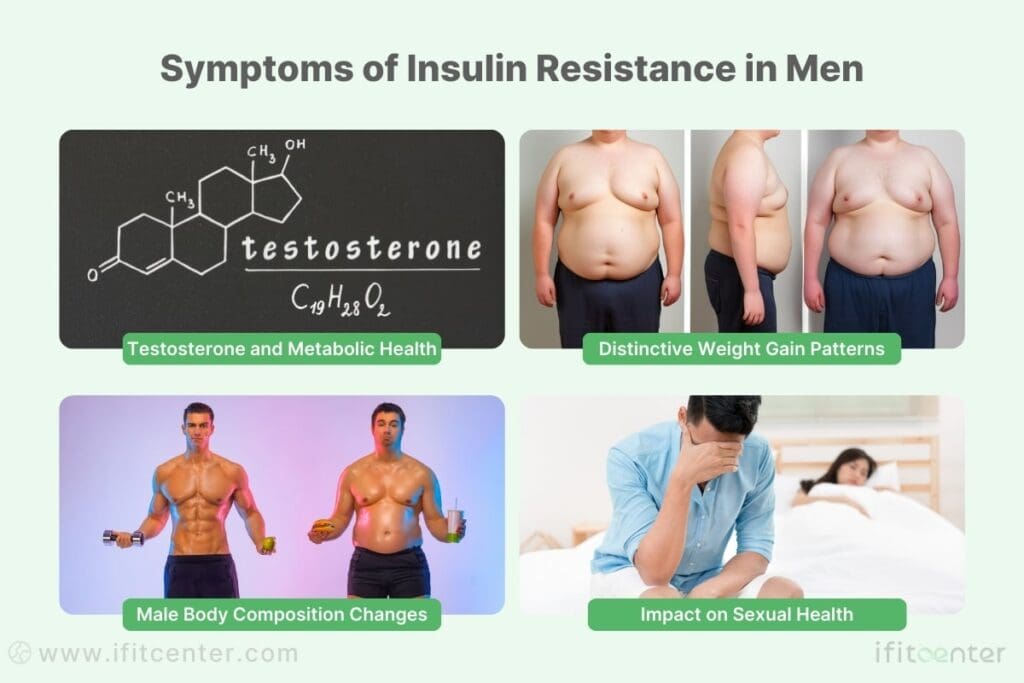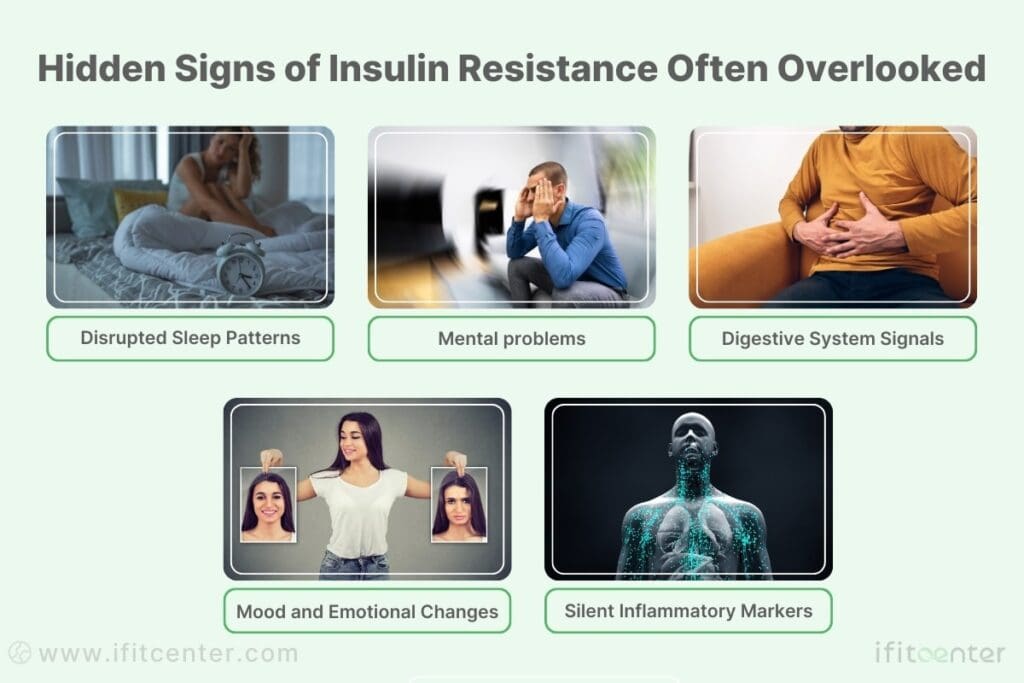When was the last time you felt truly energetic after a meal, instead of fighting the urge to take a nap? Do you find yourself constantly craving carbohydrates, no matter how recently you’ve eaten? Have you noticed subtle changes in your body – like darkened skin patches or stubborn belly fat – that you can’t quite explain?
These seemingly unrelated symptoms might be your body’s way of warning you about insulin resistance. It’s a condition that affects millions globally, yet remains largely unrecognized until it progresses to more serious health issues.
In this comprehensive guide in IFitCenter, we’ll help you understand the warning signs your body might be sending you right now – signals that could be the key to protecting your metabolic health.
Common Early Insulin Resistance Symptoms

Think of insulin resistance like a key that no longer fits perfectly in its lock. Just as a worn key might still work but require more effort, your body needs to produce more insulin to manage blood sugar. This process creates several telltale signs that can appear long before blood sugar levels rise.
“There’s a common misconception that dark patches on the skin (acanthosis nigricans) only appear in people with severe insulin resistance. However, I’ve observed that subtle skin changes, particularly a slight darkening or thickening around the base of the neck, can appear even in early stages. What’s fascinating is that these changes often reverse within the first few weeks of addressing insulin resistance, making them an excellent marker for tracking early treatment success.”
Dr. Babak Jamalian, Family Physician.
Unexplained Weight Changes
One of the earliest signs is a gradual but persistent weight gain, particularly around your midsection. This happens because insulin resistance affects how your body stores fat. Even with regular exercise and a careful diet, you might notice your waistline expanding while other areas remain unchanged.
Energy Level Fluctuations
Do you feel energetic one moment and completely drained the next? These energy “roller coasters” often occur because your body struggles to manage glucose effectively. You might feel particularly tired after meals, a condition some doctors call “postprandial fatigue.”
Skin Changes
Two distinctive skin changes often signal insulin resistance. The first is acanthosis nigricans – dark, velvety patches of skin typically appearing on your neck, armpits, or groin. The second is the development of skin tags – small, flesh-colored growths that commonly appear on the neck or underarms.
Blood Pressure Changes
High blood pressure often accompanies insulin resistance, even in people who eat a low-sodium diet and exercise regularly. This occurs because insulin resistance affects your blood vessels’ ability to relax and contract properly.
Persistent Hunger and Cravings
If you feel hungry shortly after eating or experience intense carbohydrate cravings, your body might be struggling with insulin resistance. These cravings occur because your cells aren’t effectively receiving the energy from the food you eat, triggering ongoing hunger signals.
Insulin Resistance Symptoms in Females
Women experience unique challenges with insulin resistance due to its significant impact on reproductive and hormonal health. Understanding these female-specific symptoms can lead to earlier detection and more effective treatment.
Signs of Insulin Resistance in Females – PCOS
Polycystic Ovary Syndrome (PCOS) and insulin resistance share a complex relationship. High insulin levels can trigger excess androgen production, leading to PCOS symptoms such as irregular periods, acne, and excess facial hair. Conversely, PCOS can worsen insulin resistance, creating a challenging cycle that affects both conditions.
Insulin resistance is a metabolic disease with very high prevalence. The good news is that by understanding this problem, you can easily control it or prevent it from occurring.
On the IFitCenter blog, we have provided you with a completely free content repository about insulin resistance based on a physician’s experiences as well as the latest scientific research conducted. To access the first part of the materials, you can use the links below:
- what is insulin resistance
- insulin resistance test
- insulin resistance in kids
- insulin resistance reversal
- How Long Does Insulin Resistance Treatment Take?
Menstrual Cycle Changes
Insulin resistance can significantly impact your menstrual cycle. You might notice longer gaps between periods, heavier or lighter flows, or even missed periods. These changes occur because insulin affects the delicate balance of reproductive hormones that regulate your menstrual cycle.
Fertility and Conception Challenges
Many women discover their insulin resistance while investigating fertility issues. High insulin levels can interfere with regular ovulation and create an environment less favorable for conception. The good news is that addressing insulin resistance often helps restore normal fertility patterns.
Female-Pattern Weight Distribution
Women with insulin resistance often notice a distinct pattern of weight gain. Fat tends to accumulate around the abdomen, even if you’ve historically carried weight elsewhere. This shift in fat distribution isn’t just a cosmetic concern – it’s an important metabolic signal.
Hormonal Imbalance Signs
Beyond reproductive hormones, insulin resistance can affect your entire hormonal system. You might experience mood swings, sleep disturbances, or changes in energy levels that seem more intense than usual. These fluctuations often result from the interplay between insulin and other crucial hormones in your body.
Understanding these symptoms early can make a significant difference in your metabolic and reproductive health.
Insulin Resistance Symptoms in Males

While insulin resistance affects both genders, men experience distinct symptoms that often go unrecognized. Understanding these male-specific warning signs can lead to earlier detection and more effective treatment.
Testosterone and Metabolic Health
One of the first signs men might notice is a gradual decline in testosterone levels. When insulin resistance develops, it can interfere with your body’s testosterone production. This hormonal change often occurs before other obvious symptoms appear, potentially affecting your energy, mood, and overall well-being.
Male Body Composition Changes
Insulin resistance uniquely affects how men’s bodies store and distribute fat. You might notice changes in your body shape even if your weight remains stable. The most telling sign is increased fat accumulation around your midsection, creating what medical professionals call “central adiposity.”
Distinctive Weight Gain Patterns
Men with insulin resistance typically develop a specific pattern of weight gain. Unlike general weight gain, insulin resistance causes fat to accumulate primarily in the abdominal area, even if you’ve historically carried weight elsewhere. This type of fat distribution is particularly concerning because it’s linked to various metabolic health issues.
Impact on Sexual Health
Insulin resistance can significantly affect male sexual health through multiple pathways. It may impact erectile function, libido, and overall sexual performance. These changes occur because insulin resistance affects both blood vessel function and hormone balance – two crucial factors in male sexual health.
Body Signs of Insulin Resistance – Changes in Muscle Mass
Men with insulin resistance often notice changes in their muscle mass and strength, even with regular exercise. This occurs because insulin plays a crucial role in muscle protein synthesis. When insulin resistance develops, your muscles may not receive the nutrients they need to maintain their strength and size, despite adequate protein intake and exercise.
Additional signs may include:
- Increased fatigue after meals
- Difficulty gaining muscle despite working out
- Changes in facial hair growth patterns
- Decreased recovery time from exercise
Recognizing these symptoms early is crucial for maintaining both metabolic and hormonal health. Unlike some health conditions, insulin resistance in men can often be effectively managed when caught in its early stages.
Symptoms of Insulin Resistance in Children and Adolescents
Recognizing insulin resistance in young people can be challenging because many symptoms overlap with normal growth and development. However, certain signs should prompt parents to seek professional evaluation.
To view the second part of content related to insulin resistance, I invite you to use the links below:
- insulin resistance supplements
- foods for insulin resistance
- can insulin resistance lead to diabetes?
- how to stop insulin weight gain?
- Is Fasting Good for Insulin Resistance?
- which cooking oil is good for health
Changes in Growth and Development
Insulin plays a crucial role in childhood growth. Children with insulin resistance might experience unexpected changes in their growth patterns, including rapid weight gain that doesn’t match their height increase. Some children may show signs of early puberty, while others might have delayed growth milestones.
Does Insulin Resistance Cause Fatigue?
Children with insulin resistance may show unusual patterns in their energy levels. They might feel extremely tired after meals, have difficulty participating in physical activities they previously enjoyed, or experience sudden energy crashes during the day. This differs from normal childhood tiredness and deserves attention.
Insulin Resistance Skin Changes
Youth-specific skin changes can be important indicators of insulin resistance. Dark patches of skin (acanthosis nigricans) might appear around the neck or in body folds. Unlike adult skin changes, these signs in children often appear earlier in the progression of insulin resistance and can be easier to spot.
Warning Signs Parents Should Watch For
- Unexplained weight gain, especially around the abdomen
- Excessive thirst or frequent urination
- Difficulty keeping up with peers during physical activities
- Changes in sleep patterns or increased sleepiness
- Early signs of puberty compared to peers
Early detection and intervention in children is particularly important as it can prevent the development of more serious health conditions in their future.
To access the second part of the insulin resistance content, I invite you to use the links below:
- insulin resistance supplements
- can insulin resistance lead to diabetes?
- insulin resistance weight gain
- worst foods for insulin resistance
Hidden Signs of Insulin Resistance Often Overlooked

While weight gain and fatigue are commonly known signs of insulin resistance, several subtle signals often go unnoticed. Understanding these hidden indicators can lead to earlier detection and more effective treatment.
“Many patients are surprised to learn that sleep disturbances, particularly difficulty maintaining sleep, may be linked to early insulin resistance. Clinical studies suggest that disrupted sleep patterns can affect cortisol rhythms, which play a role in metabolic regulation. If you experience frequent nocturnal awakenings accompanied by daytime fatigue, it may be prudent to assess insulin sensitivity through methods like OGTT or HOMA-IR, even if fasting glucose levels appear normal.”
Dr. Babak Jamalian, Family Physician.
Disrupted Sleep Patterns
If you find yourself tossing and turning at night or feeling exhausted despite getting enough sleep, insulin resistance might be the culprit. The connection lies in how insulin affects your body’s stress hormones and circadian rhythm. You might notice:
- Difficulty falling asleep despite feeling tired
- Waking up frequently during the night
- Morning grogginess that persists throughout the day
- Sudden energy crashes in the afternoon
Subtle Cognitive Changes
Your brain is particularly sensitive to changes in insulin levels. Long before diabetes develops, you might experience cognitive changes that seem unrelated to blood sugar. These can include:
- Brain fog after meals
- Difficulty concentrating on tasks
- Memory lapses
- Decreased mental clarity
Mood and Emotional Changes
Insulin resistance can affect your emotional well-being in surprising ways. Many people attribute these changes to stress or aging, not realizing they’re connected to metabolic health. Watch for:
- Unexplained irritability
- Anxiety that worsens with hunger
- Mood swings coinciding with meals
- Increased stress sensitivity
Digestive System Signals
Your digestive system often sends early warning signals about insulin resistance. These gut-related changes occur because insulin affects both nutrient absorption and gut barrier function:
- Bloating after meals
- Changes in appetite signals
- Irregular digestive patterns
- Increased food sensitivities
Silent Inflammatory Markers
While these signs require medical testing to detect, understanding their presence can help explain other symptoms you’re experiencing. Common inflammatory markers associated with insulin resistance include:
- Elevated C-reactive protein levels
- Changes in blood lipid patterns
- Increased oxidative stress markers
- Altered immune system responses
Recognizing these subtle signs early can help prevent the progression of insulin resistance and its associated health complications. If you notice several of these hidden signals, it’s worth discussing them with a healthcare provider.
Reverse Insulin Resistance with Medical Supervision
Insulin resistance doesn’t happen overnight, but the good news is you can reverse it with the right strategy. Studies show that targeted weight loss, nutritional modifications, and medical supervision are the effective ways to restore insulin sensitivity.
At IFitCenter, we offer:
✅ Medically supervised weight loss programs that target insulin resistance
✅ Personalized nutrition plans to balance blood sugar and reduce cravings
✅ Advanced body composition analysis to track fat loss, not just weight loss
Don’t wait until insulin resistance becomes a bigger problem—take control of your metabolic health today.
To access other content on the IFitCenter’s blog, you can use the following links:
Scientific References for Signs of Insulin Resistance
- Karastergiou K, Mohamed-Ali V, Jahangiri M, Kaski JC. Biomarkers of insulin sensitivity/resistance: An updated comprehensive review. Journal of Hypertension. 2024;42(1):23-38. DOI: 10.1177/03000605241285550
- Fukushima M, Usami M, Ikeda M, et al. Insulin resistance and associated risk factors in patients with type 2 diabetes mellitus. Hypertension Research. 2024;47(1):14-23. DOI: 10.1038/s41440-023-01566-7
- Gastaldelli A. Measuring and estimating insulin resistance in clinical and research settings. Obesity. 2022;30(7):1299-1309. DOI: 10.1002/oby.23503
- Gao F, Wang G, Wang L, et al. The crucial role and mechanism of insulin resistance in metabolic disease: A comprehensive review. Frontiers in Endocrinology. 2023;14:1149239. DOI: 10.3389/fendo.2023.1149239
- American Diabetes Association Professional Practice Committee. Standards of Medical Care in Diabetes—2024. Diabetes Care. 2024;47(Supplement 1):S1-S455. DOI: 10.2337/dc24-SINT



